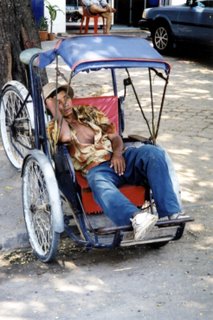Monday, April 26, 2004
Hello from Phnom Penh!

After a 27-hour voyage, I finally arrived in Phnom Penh, the capital city of Cambodia. Along the way, we stopped in London and in Bangkok. The flight took us over such exotic locales as Hungary, Afghanistan and Nepal.
The last leg of the trip was a one-hour flight from Bangkok to Phnom Penh. That flight was not simply a 500-kilometre trip; it was more like a trip back in time. Leaving Bangkok airport with numerous 747's parked on the tarmac, I looked out the airplane window. Bangkok appeared to be an extremely modern city, with superhighways packed with cars and a many tall skyscrapers. As the plane approached Phnom Penh, only dirt roads were evident. There were barely any vehicles on those roads and the only buildings were ramshackle huts along the banks of very muddy-looking rivers. There were maybe five small planes parked at the Phnom Penh airport.
We were driven to our hotel, which is one of the most luxurious in town - quite the contrast with the typical residence in this city. I am staying on the executive floor of the hotel, with a view overlooking the Mekong River. The hotel is well located. It is next to the King's palace and close to the Cambodian Ministry of God and Religion (!) and the Ministry of Information.
Phnom Penh reminds me of Saigon, but is slightly less chaotic and less crowded. It is mostly a 3rd world type of city with many slum-like apartment blocks and some unpaved roads. However, like most poor places, it is a city of contrasts: There are also quite a few luxurious villas surrounded by walls; often these villas are located right next to the dilapidated residences. The residents of the villas are either foreign workers or corrupt local officials.
Most streets are fairly well paved, but some are dirt roads. The city is very dusty.
The city is very safe to walk around. Once you have passed through the barrage of young men outside the hotel offering you a lift on their motorbike (you simply say no thank you a couple of times to each of them and then they go away), you can walk around the city and basically not be bothered. The only impediments to a safe and enjoyable walk are the intense heat (38 degrees Celsius and humid) and the crazy drivers. Most of the vehicles are motorbikes, although there are more cars and SUV's than I had expected. There are minimal rules of the road. At a typical major intersection, nobody stops in any of the four directions. Motorbikes, cars and bicycles somehow blend together and nobody runs into anybody else.
Crossing the street takes a certain amount of skill (although J-walking in Montreal is excellent preparation). Essentially, there is never a clear opening in traffic for you to cross in one shot. You have to throw yourself into the chaos and slowly walk among the cars and motorbikes (that hopefully weave around you).
The Cambodian people are friendly and seem quite shy. Even if you refuse their offer of a ride or an offer to sell you something, they still smile and often giggle in a shy sort of way. There are almost no beggars. Instead, you are often approached by someone offering to sell something potentially useful like a newspaper or a service of some sort. For example, I was sitting with Stefan (my teaching colleague) at a sidewalk cafe and a shoeshine boy noticed that Stefan's sandals were frayed. Through sign language (few people here speak English - or any language other than Khmer), he offered to repair and shine Stefan's sandals. He did a great job and I was impressed by the fact that he saw a need and attempted to fulfill it.
One thing that strikes you is the large number of young people. Half of Cambodia's population of 13 million is under the age of 20. Having a young population means that the country has a strong potential, but the economy will have to expand sufficiently to accommodate the 500,000 people who are expected to enter the workforce in each of the coming years.
We visited a couple of markets, which I suppose are the forerunner of shopping malls. Essentially, these markets are crowded and chaotic and you can buy nearly anything there - mainly from small owner-operated stalls. There is even an area of the market with basic soup and noodle stands - the forerunner of the food court!
We walked into a local Wat (temple). Many Buddhist monks, with shaved heads and wearing orange robes, were milling about.
We also visited the Toul Sleng prison where over 12,000 people were imprisoned and then put to death by the Khmer Rouge between 1976 and 1979. The museum there describes the crimes of the Cambodian rulers of that era (See the movie "The Killing Fields").
Essentially, in its bid to create an agrarian utopia, the regime led by Pol Pot created massive rural communes and abolished money, education and religion. Under its 1975-79 rule, up to two million people perished from torture, overwork, starvation and disease.
The Khmer Rouge killed nearly all the educated people, including just about all the lawyers. Only recently has a bar association been re-established and it is at the bar school that I will be teaching for the next five days. Our students are the future lawyers of Cambodia.
At the present time, there are only 300 lawyers in all of Cambodia. The legal system is not effective. Judges are corrupt and it is in part because of this corruption that the leaders of the Khmer Rouge have yet to be prosecuted. Hopefully by re-establishing a legal community, Cambodia can ensure that the rule of law will apply.
In my next e-mail, I will let you know what a Cambodian law school is like.
Take care.
--Larry
